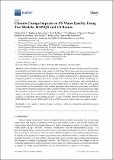| dc.contributor.author | Fant, Charles | |
| dc.contributor.author | Srinivasan, Raghavan | |
| dc.contributor.author | Rennels, Lisa | |
| dc.contributor.author | Chapra, Steven | |
| dc.contributor.author | Corona, Joel | |
| dc.contributor.author | Allen, Ashley | |
| dc.contributor.author | Martinich, Jeremy | |
| dc.contributor.author | Boehlert, Brent B. | |
| dc.contributor.author | Strzepek, Kenneth | |
| dc.date.accessioned | 2017-06-08T13:15:17Z | |
| dc.date.available | 2017-06-08T13:15:17Z | |
| dc.date.issued | 2017-02 | |
| dc.date.submitted | 2016-11 | |
| dc.identifier.issn | 2073-4441 | |
| dc.identifier.uri | http://hdl.handle.net/1721.1/109730 | |
| dc.description.abstract | Climate change and freshwater quality are well-linked. Changes in climate result in changes in streamflow and rising water temperatures, which impact biochemical reaction rates and increase stratification in lakes and reservoirs. Using two water quality modeling systems (the Hydrologic and Water Quality System; HAWQS and US Basins), five climate models, and two greenhouse gas (GHG) mitigation policies, we assess future water quality in the continental U.S. to 2100 considering four water quality parameters: water temperature, dissolved oxygen, total nitrogen, and total phosphorus. Once these parameters are aggregated into a water quality index, we find that, while the water quality models differ under the baseline, there is more agreement between future projections. In addition, we find that the difference in national-scale economic benefits across climate models is generally larger than the difference between the two water quality models. Both water quality models find that water quality will more likely worsen in the East than in the West. Under the business-as-usual emissions scenario, we find that climate change is likely to cause economic impacts ranging from 1.2 to 2.3 (2005 billion USD/year) in 2050 and 2.7 to 4.8 in 2090 across all climate and water quality models. | en_US |
| dc.description.sponsorship | United States. Environmental Protection Agency. Climate Change Division (EP-BPA-12-H-0024) | en_US |
| dc.description.sponsorship | United States. Environmental Protection Agency. Office of Water (EP-G15H-01113) | en_US |
| dc.language.iso | en_US | |
| dc.publisher | MDPI AG | en_US |
| dc.relation.isversionof | http://dx.doi.org/10.3390/w9020118 | en_US |
| dc.rights | Creative Commons Attribution 4.0 International License | en_US |
| dc.rights.uri | http://creativecommons.org/licenses/by/4.0/ | en_US |
| dc.source | MDPI | en_US |
| dc.title | Climate Change Impacts on US Water Quality Using Two Models: HAWQS and US Basins | en_US |
| dc.type | Article | en_US |
| dc.identifier.citation | Fant, Charles; Srinivasan, Raghavan; Boehlert, Brent; Rennels, Lisa; Chapra, Steven; Strzepek, Kenneth; Corona, Joel; Allen, Ashley and Martinich, Jeremy. “Climate Change Impacts on US Water Quality Using Two Models: HAWQS and US Basins.” Water 9, no. 2 (February 2017): 118 © 2017 The Authors | en_US |
| dc.contributor.department | Massachusetts Institute of Technology. Joint Program on the Science & Policy of Global Change | en_US |
| dc.contributor.mitauthor | Boehlert, Brent B. | |
| dc.contributor.mitauthor | Strzepek, Kenneth | |
| dc.relation.journal | Water | en_US |
| dc.eprint.version | Final published version | en_US |
| dc.type.uri | http://purl.org/eprint/type/JournalArticle | en_US |
| eprint.status | http://purl.org/eprint/status/PeerReviewed | en_US |
| dspace.orderedauthors | Fant, Charles; Srinivasan, Raghavan; Boehlert, Brent; Rennels, Lisa; Chapra, Steven; Strzepek, Kenneth; Corona, Joel; Allen, Ashley; Martinich, Jeremy | en_US |
| dspace.embargo.terms | N | en_US |
| dc.identifier.orcid | https://orcid.org/0000-0001-9494-785X | |
| mit.license | PUBLISHER_CC | en_US |
